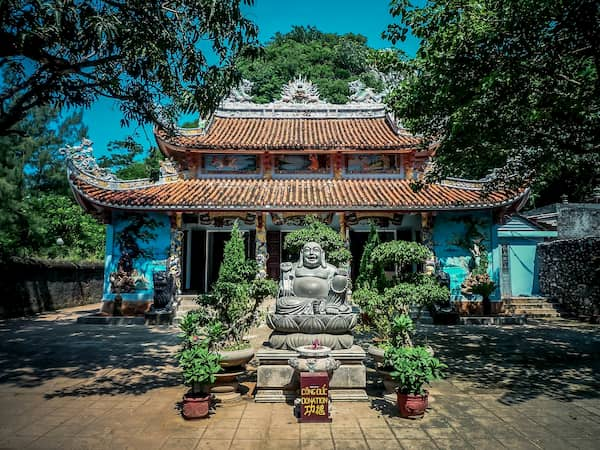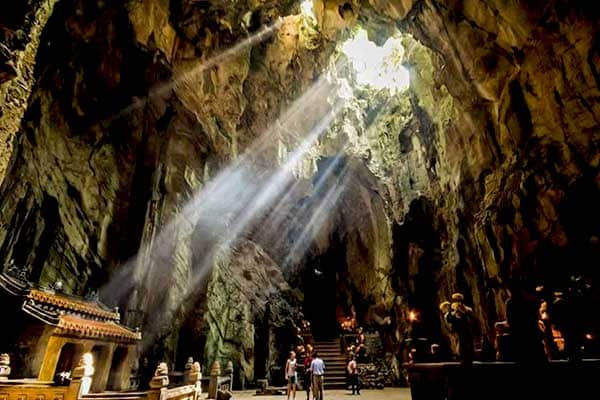MARBLE MOUNTAINS - CENTRAL VIETNAM
DISCOVER THESE LEGENDARY MOUNTAINS
Located about 8 km southeast of the city of Da Nang in central Vietnam, five marble mountains have been named after the five basic elements of the universe. We discover mysterious caves and isolated pagodas while enjoying the sea breeze.
The legends of the marble mountains
If you look down from above, the Hai Van Pass, Ba Na Hill and the Ngu Hanh Son marble mountains look like a "gigantic natural rock", a precious gift from nature to the city of Da Nang. Historical and cultural landmarks have been preserved in every Buddhist temple, as well as every Cham sculpture and poetic writings.
Many legends about these mountains in central Vietnam have spread by word of mouth. According to a local tale, the mountains come from egg shells. It is said that a golden turtle arrived at the seaside and laid five eggs. When the eggs hatched, their shells turned into five mountains. Each mountain is made of marble of different colours - pink, white, red, brown. These colours change according to lighting conditions. Tranquil and mysterious, the mountains have attracted kings who wanted to admire their splendour. When King Minh Mang came here in the 19th century, he considered the beauty of the caves and pagodas as the pride of his kingdom. It is also this king who baptized the mountains according to the five elements: Kim Son (metal mountain), Thuy Son (water mountain), Moc Son (wooden mountain), Hoa Son (fire mountain) and Tho Son (earth mountain).

Pagoda in Marble Mountains
The marble mountains have inspired great poets. The poems of the Le and Tran dynasties have been preserved so that the younger generations can enjoy handwriting carved into the walls of the caves at the top of the cliffs. Cultural and historical remains are still present in each pagoda and tower from the early 19th century and on Champa's sculptures from the 14th and 15th centuries. All the monuments, such as the tomb of General Tran Quang Khai's mother, Tam Thai Pagoda, Da Chong Tunnel, Hell's Cave, etc. are convincing evidence of the legendary marble mountains.
What to see in the Marble Mountains?
Earth Mountain
Located northwest of Ngu Hanh Son, the inhabitants often call it Da Chong Mountain or Ghenh Mountain. It is a mountain of earth, the lowest but also the longest, which looks like a dragon lying on the sand. The mountain itself has a thin layer of coloured grass; some parts show the colour of red clay. There are many old bricks on the mountain, they are remains left by the Cham people.
Some monuments on the mountain of Terre
- Long Hoa Pagoda
- The Hue Quang Pagoda
- Ben Ngu (During the Nguyen dynasty, whenever the king visited the marble mountain, the boat was stopped there)
- Coc cave or De Bo cave (During the war of resistance against the French, the army and the inhabitants used this cave to avoid the enemy.)
Water Mountain
Thuy Mountain is located north of the marble mountain, it is the largest and most beautiful mountain for tourists. Thuy Son is located over a vast area to the northeast, on about 7 hectares, for 106 m high, with three peaks located on three floors like three stars.
This mountain has many Buddhist caves and temples, many of which date back to the 17th century. In the past, Tam Thai Pagoda paid tribute to the Hindu and Buddhist gods and is now dedicated to the Cham deities. Caves as beautiful as Linh Nham Cave, Van Thong Cave, Tang Chon Cave and Huyen Khong Cave are also on the cliff of the mountain. The Huyen Khong Cave was the base of Vietnamese revolutionaries in wartime.
To climb into the caves and temples of this mountain, you have two ways: the western gate which consists of 156 natural stone steps leading to the Tam Thai Pagoda or the eastern gate which consists of 108 steps leading to the Linh Ung Pagoda. Most tourists go up to the west gate and down to the east gate.
Cave of Hell
At the top of the Thuy mountain, there are mysterious and obscure caves as the name Hell's Cave indicates. By crossing the Nai Ha bridge, visitors enter a world that resembles the afterlife, where the penalties associated with sin are illustrated. In the Am Phu cave, there are many nooks and crannies that symbolize the floors of hell.

Cave in Marbles Mountains
Tam Thai Pagoda
Located southwest of Mount Thuy, Tam Thai Pagoda is located on a flat site, with a circumference of 200 meters. The temple was built at the time when the ancient city of Hoi An had just formed. The old Tam Quan gate in front of the temple consists of three gates, according to the rules of the royalist era, the main gate is the highest and most solemn gate reserved for monks, on the left for men, and the right gate for women.
Viewpoint Vong Giang
By climbing about 150 stone steps at the foot of Thuy Son, you will reach the most beautiful observatory: the View Tower at the river or the Vong Giang Tower in Vietnamese. The tower was built in the 18th century by King Minh Mang, offering a breathtaking view of Kim Son or the metal mountain, the Truong Giang and Cam Le rivers, the beautiful coast.
Metal Mountain
Kim Son Mountain is located to the southeast, on the banks of the Co Co Co River. At the foot of Bodhisattava Avalokiteshvara, a dragon rolls between the waves. Behind the Bodhisattava is a peacock with its wings spread. All are natural sculptures created by stalactite.
Wood Mountain
This mountain is located to the east, near the beach. The east and south sides are sandy, the north is wide and to the west is a peaceful village. There is a white marble rock called Co Mu.
Mountain of Fire
Hoa Son is located on the bank of the Co Co River. On the rock, three large Chinese characters Duong Hoa Son are engraved. There are some cellars and a temple called Pho Son Da.
Village Non Nuoc
At the foot of the marble mountains, the village is famous for its stone sculptures. You can buy marble souvenirs such as earrings, necklaces, vases with huge Buddha sculptures,...In the past, rock was extracted directly from the marble mountains to make sculptures, but extraction is now illegal. Materials for sculptural work are transported from neighbouring provinces such as Quang Nam and Thanh Hoa. Original souvenirs to bring back from your trip to Central Vietnam!



